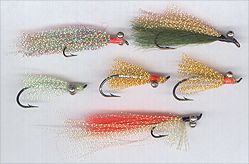Adding sparkle or flash to a fly nowdays is a piece of cake. With the development of synthetic materials the fly tyer has an almost unlimited opportunity to add some dazzling eycatchers to those mundane patterns. And a whole new wave of exotic creations are appearing in flyboxes....some even catch fish!
Generically speaking, sparkle flies use a variety of prismatic synthetics which bend and refract the light, often in a spectrum of colors. The old traditional materials like mylar and tinsel have been used for a long time to add a bit of flash to a fly. Now we can do it in every color of the rainbow, or all the colors of the rainbow at once.
 The flies displayed here are an off-shoot of the popular coho streamer fly used by just about everyone who fishes for sockeye salmon in Alaska. The origin of this fly resulted from the need to have a much more visible pattern in the water for sightfishing/casting to sockeye moving upstream in clear water.
The flies displayed here are an off-shoot of the popular coho streamer fly used by just about everyone who fishes for sockeye salmon in Alaska. The origin of this fly resulted from the need to have a much more visible pattern in the water for sightfishing/casting to sockeye moving upstream in clear water.
The first year I tried one I became totally convinced that this is an excellent clearwater sockeye fly. While fishing on the Russian River one day, I hooked up 21 reds in 3 1/2 hours with only TWO being foul-hooked. It was a "record" I haven't beat to this day. My switch to this pattern was due to the exceptional reflectivity of color the fly produced once it is in the water. When you are timing your casts and drifts to cross in front of moving fish, knowing where your fly is at all times is critical. Sockeye have a 6-12" zone in front of them that many times will provoke a strike on a fly.
The store-bought versions found locally run about $1 per fly. Orange and yellow sparkle patterns appear to show up best in the water and seem to be the most effective color for the fish to strike. (My personal preferences.) They are very easy to tie up following a typical streamer routine.
Weighted flies are illegal on the Russian and in the Kenai/Russian confluence Fly Fishing Only area. The beaded eyes, being an integral part of the shrimp pattern it immitates helps sink the fly and get it in the zone a bit quicker.
When fishing murky or glacial waters where the sockeye cannot see the fly, its best to go back to the 3 for a buck coho flies since those fishing conditions result in more foul-hooked fish and broken lines and lost flies.



